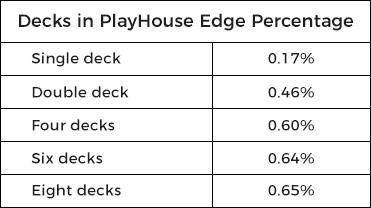

Blackjack Rules: All You Need to Know
The modern game of blackjack has not changed all that much over the past few decades and the advent of new technologies have only served to fuel fascination with the game. Aside from the fact that blackjack rules are simple and easy to learn, the game can be played in the comfort of your own home, or even on the go via your mobile device of choice.
UK punters looking to explore and play live blackjack & regular blackjack online often wonder if the rules are different. However, you may delighted to learn that the blackjack rules UK online casinos use are exactly the same as other casinos. Of course, you may find some variation in the rules based on special version of the game but, for the most part, blackjack rules and gameplay remains consistent.
You will often hear people state that the object of the game of blackjack is to reach a score of 21. However, this is only partially true. To be more accurate, the objective of the game is to beat the dealer and in order to do that successfully, the player must ensure that they do not exceed a total of 21. That is one thing; the other is to always have a higher scoring hand than the dealer at the end of the round.
At Play UK Casino, classic blackjack is played with a standard deck of cards (52 cards) and can consist of a single deck game or up to as many as eight decks. The game can be played with just one player or several, all positioned around the blackjack table and who play individually against the dealer (the house).

Blackjack Rules Overview
Blackjack rules are very easy to learn and cover everything from the rules that govern the opening of each round or hand, to more complex rules that govern special betting options such as surrender, insurance, splitting and doubling down.
Blackjack Rules on Card Values
In standard blackjack, every card in the deck is assigned a specific value, which counts in how hands are made and whether a given hand is strong enough to be a winning hand. The actual values that make up each hand will also determine what each player will be able to do during the betting phase of the game. So it makes sense to know how each card is valued and how it can be used to win the game.
Blackjack rules on card values are as follows:
- Ace cards can be counted as either 1 or as 11
- Cards marked 2 through to 10’s a retain their face value
- Face cards (kings, queens, jacks) are valued at 10
- Card hands are valued as the combined total of each card value in the hand
-
A value of 21 made with a combination of an ace and a jack outranks any other combined card value that makes 21
Blackjack Basic Rules of Play
The basic rules that govern blackjack gameplay can be divided into several simple steps, each with its own set of actions. The basic sequence that every round of blackjack follows can be summarised in these steps:
- Initial deal
- Player Response Options
- Dealer Reveals hole card
- Winning and losing hands bets settled
The Initial Deal
Every round of blackjack begins with players placing their bets around the blackjack table. The dealer will then deal two cards to each player around the table. The dealer then gives himself two cards. However, there is a bit of a twist here. While all the players around the table receive their two cards face up, the dealer will only have his first card showing (face up), while his second card will be face down. This is known as the ‘hole card’ and, just as in poker, this card value will only be revealed towards the end of the round.
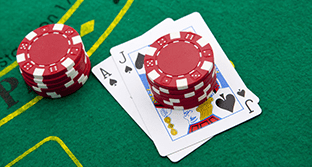
Rules Regarding Blackjack Insurance
According to blackjack dealer rules, if the dealer's up card is showing either an ace or a ten, he will then offer a side bet, known as insurance, to all players. Insurance is a side bet that pays out at 2:1 if it turns out that the dealer's hole card is valued at 10. Of course, you don’t have to take insurance if you don’t want to, it’s not compulsory at this stage, although if you do, your insurance wager can’t exceed half of your original wager. Another important point to note at this stage is that, if the dealer does have a 10 or an ace facing up, he will then take a peek at his hole card to see if it is a 10 or ace card. If it is, he will turn it over immediately and, if the dealer has blackjack, all hands around the table will lose, with the exception of insurance bets, which get their payout and any player blackjack hands, which result in a push.
Rules Regarding Player Response Options
After every player at the blackjack table has received their initial two cards from the dealer, they can then respond based on what the rules allow for and what their two-card hand dictates they should do. One of the advantages of blackjack is that players are afforded a wide range of options, which can go a long way in obtaining that much-desired win. It is also important to understand that each of these options is accompanied by a specific hand gesture or signal. This not only tells the dealer what your intention is, in brick and mortar casinos it is also required for casino security monitoring every play at the blackjack tables. Of course, with online blackjack UK hand gestures are replaced with mouse clicks on the applicable options. The following outlines all the rules regarding player response options after the initial two card hands have been dealt.
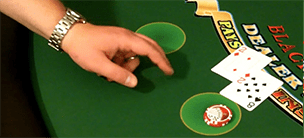
Hit
Any player that has received two cards and finds that their combined total is insufficient in presenting a competitive hand against the dealers, can indicate to the dealer that they would like another card. The number of cards that a player can receive is not limited unless they exceed a total of 21, in which case they ‘bust’ meaning they automatically forfeit their hand.
Stand
Of course, if your initial hand is 17 or higher, you may wish to stay with your hand and not risk adding additional cards to your total. The possibility of a bust is high and players with strong hands can choose to stay with their current total by indicating to the dealer that they will ‘stand’ with their current hand.
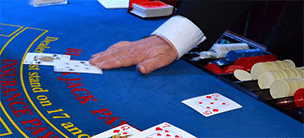
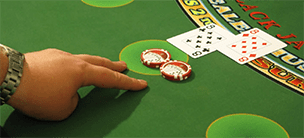
Rules Regarding a Split Bet
A great option if you have two cards of equal value. You can then split them into two new bets, each with its own wager amount. To do this, move the new hand next to the first hand, which is in the betting box. The dealer will then separate the two cards, drawing two new cards, one for each hand. The player can then play both hands as independent hands and they will win or lose accordingly. Depending on the game, any initial two-card hand containing ten value cards can be split if both cards are tens, while in other games any ten/king hand can also be split. Re-splitting of new hands as well as doubling down of new hands will depend on the game.
Double Down
Doubling down allows players to increase their initial bet to double its value with the catch being that they have to stand after receiving one more card from the deck. The additional card is then placed in the bet box next to their original bet.
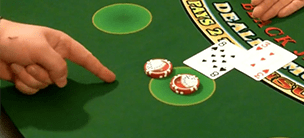
Surrender
This option allows you to forfeit half of your wager and keep the other half and, at the same time, surrender your hand. This option is great if you know the dealer has blackjack but it only works on your first two cards.
Rules Regarding Gameplay at the Table
Gameplay at the blackjack table will move in a clockwise fashion, moving from one player to the next individually. After the first player makes their moves, as described in the above list of betting options, the dealer will proceed to the next player in turn until all players at the table have had a turn to select their preferred betting options.
Dealer Reveals Hole Card
After all players at the table have concluded betting, the dealer will then reveal his hole card. Based on this, the dealer will also stand or draw more cards in accordance with the rules set out governing dealer behaviour at this stage. Once the dealer’s hand has been established, all bets that remain on the table (those that did not bust) are resolved, this time in a counter-clockwise motion. Losing bets are obviously forfeit to the house while push bets (draw) are left on the table and any winning bets are paid out.

Blackjack Dealer Rules on Drawing
Blackjack games have multiple dimensions, which work on both sides of the blackjack table. Depending on the blackjack game, there are certain rules, which the dealer must adhere to in the game, which can include:
- Hitting on 16: A blackjack dealer must hit on 16 or less after turning over his hole card. In some games, if a dealer has an ace as well as 6 points made from one or more cards, this is known as a soft 17 and, in some games, he is required to hit on this total too.
- Dealer bust: If the dealer’s draw goes over 21 he will bust and anyone still in the game (that didn’t bust as well) will automatically win.
-
Dealer hits soft 17: A soft 17 in blackjack consists of an ace card and any combination of 6. Depending on the game, the dealer must either hit on a soft 17 (H17), or stand on soft 17 (S17). Games that require the dealer to stand on a soft 17 offers a better house edge for the player at around 0.2%.
A Quick Word on the Number of Decks in Play in Blackjack
Blackjack games can either use a single deck or multiple decks and the fewer decks involved, the better the house edge percentage will be for the player. The following shows the correlation between the number of decks in play and the relevant house edge percentages.
